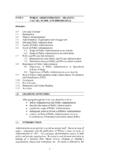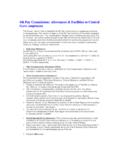Transcription of Load Runner - freewebs.com
1 Sanjay Kumar Load Runner Tutorials Load Runner Introduction LoadRunner enables you to test your system under controlled and peak load conditions. To generate load, LoadRunner runs thousands of Virtual Users that are distributed over a network. Using a minimum of hardware resources, these Virtual Users provide consistent, repeatable, and measurable load to exercise your application just as real users would. LoadRunner s in-depth reports and graphs provide the information that you need to evaluate the performance of your application. LoadRunner emulates an environment in which thousands of users work with a client/server system concurrently. To do this, LoadRunner replaces the human user with a virtual user (Vuser). The actions that a Vuser perform are described in a Vuser Script. The LoadRunner advantages over Manual performance testing: LoadRunner reduces the personnel requirements by replacing human users with virtual users or Vusers.
2 These Vusers emulate the behavior of real users operating real applications. Because numerous Vusers can run on a single computer, LoadRunner reduces the hardware requirements. The LoadRunner Controller allows you to easily and effectively control all the Vusers from a single point of control. LoadRunner monitors the application performance online, enabling you to fine-tune your system during test execution. LoadRunner automatically records the performance of the application during a test. You can choose from a wide variety of graphs and reports to view the performance data. LoadRunner checks where performance delays occur: network or client delays, CPU performance, I/O delays, database locking, or other issues at the database server. LoadRunner monitors the network and server resources to help you improve performance. Because LoadRunner tests are fully automated, you can easily repeat them as often as you need.
3 Load Runner Sanjay Kumar Load Runner Tutorials Some of the most commonly used Terms in the LoadRunner Scenarios: Using LoadRunner, you divide your application performance testing requirements into scenarios. A scenario defines the events that occur during each testing session. Thus, for example, a scenario defines and controls the number of users to emulate, the actions that they perform, and the machines on which they run their emulations. Vusers: In the scenario, LoadRunner replaces human users with virtual users or Vusers. When you run a scenario, Vusers emulate the actions of human users working with your application. While a workstation accommodates only a single human user, many Vusers can run concurrently on a single workstation. In fact, a scenario can contain tens, hundreds, or even thousands of Vusers. Vuser Scripts: The actions that a Vuser performs during the scenario are described in a Vuser script.
4 When you run a scenario, each Vuser executes a Vuser script. The Vuser scripts include functions that measure and record the performance of your application s components. Transactions: To measure the performance of the server, you define transactions. A transaction represents an action or a set of actions that you are interested in measuring. You define transactions within your Vuser script by enclosing the appropriate sections of the script with start and end transaction statements. For example, you can define a transaction that measures the time it takes for the server to process a request to view the balance of an account and for the information to be displayed at the ATM. Rendezvous points: You insert Rendezvous points into Vuser scripts to emulate heavy user load on the server. Rendezvous points instruct Vusers to wait during test execution for multiple Vusers to arrive at a certain point, in order that they may simultaneously perform a task.
5 For example, to emulate peak load on the bank server, you can insert a rendezvous point instructing 100 Vusers to deposit cash into their accounts at the same time. Controller: You use the LoadRunner Controller to manage and maintain your scenarios. Using the Controller, you control all the Vusers in a scenario from a single workstation. Load Runner Sanjay Kumar Load Runner Tutorials Load generator: When you execute a scenario, the LoadRunner Controller distributes each Vuser in the scenario to a load generator. The load generator is the machine that executes the Vuser script, enabling the Vuser to emulate the actions of a human user. Performance analysis: Vuser scripts include functions that measure and record system performance during load-testing sessions. During a scenario run, you can monitor the network and server resources. Following a scenario run, you can view performance analysis data in reports and graphs.
6 LoadRunner Vuser Types LoadRunner has various types of Vusers. Each type is designed to handle different aspects of today s system architectures. You can use the Vuser types in any combination in a scenario in order to create a comprehensive application test. The following Vuser types are available: Client/Server : For MSSQLS erver, ODBC, Oracle (2-tier), DB2 CLI, Sybase Ctlib, Sybase Dblib, Windows Sockets and DNS protocols. Custom: For C templates, Visual Basic templates, Java templates, Javascript and VBScript type scripts. Distributed Components: For COM/DCOM, Corba-Java, and Rmi-Java protocols. E-business: For FTP, LDAP, Media Player, Multi Protocol Web/WS, Web (HTTP, HTML), Palm, and RealPlayer protocols. Enterprise Java Beans: For EJB Testing and Rmi-Java protocols. ERP: For Oracle NCA, Peoplesoft (Tuxedo), SAP, and Siebel protocols. Legacy: For Terminal Emulation (RTE).
7 Mailing Services: Internet Messaging (IMAP), MS Exchange (MAPI), POP3, and SMTP. Middleware: For the Tuxedo (6, 7) protocol. Wireless: For i-Mode, VoiceXML, and WAP protocols. Load Runner Sanjay Kumar Load Runner Tutorials The LoadRunner Testing Process You can easily create and run load-test scenarios by following the LoadRunner testing process below. The following illustration outlines the testing process: Step I: Planning the Test Successful load testing requires that you develop a thorough test plan. A clearly defined test plan will ensure that the LoadRunner scenarios that you develop will accomplish your load testing objectives. Step II: Creating the Vuser Scripts Vusers emulate human users interacting with your Web-based application. A Vuser script contains the actions that each virtual user performs during scenario execution. In each Vuser script you determine the tasks that will be: Performed by each Vuser Performed simultaneously by multiple Vusers Measured as transactions Load Runner Sanjay Kumar Load Runner Tutorials Step III: Creating the Scenario A scenario describes the events that occur during a testing session.
8 A scenario includes a list of machines on which Vusers run, a list of scripts that the Vusers run, and a specified number of Vusers or Vuser groups that run during the scenario. You create scenarios using the LoadRunner Controller. Creating a Manual Scenario You create a scenario by defining Vuser groups to which you assign a quantity of individual Vusers, Vuser scripts, and load generators to run the scripts. You can also create a scenario using the Percentage Mode, in which you define the total number of Vusers to be used in the scenario, and the load generator machines and percentage of the total number of Vusers to be assigned to each Vuser script. Creating a Goal-Oriented Scenario For Web tests, you can create a goal-oriented scenario, in which you define the goals you want your test to achieve. LoadRunner automatically builds a scenario for you, based on these goals.
9 Step IV: Running the Scenario You emulate user load on the server by instructing multiple Vusers to perform tasks simultaneously. You can set the level of load by increasing and decreasing the number of Vusers that perform tasks at the same time. Before you run a scenario, you set the scenario configuration and scheduling. This determines how all the load generators and Vusers behave when you run the scenario. You can run the entire scenario, groups of Vusers (Vuser groups), or individual Vusers. While a scenario runs, LoadRunner measures and records the transactions that you defined in each Vuser script. You can also monitor your system s performance online. Step V: Monitoring a Scenario You can monitor scenario execution using the LoadRunner online run-time, transaction, system resource, Web resource, Web server resource, Web application server resource, database server resource, network delay, streaming media resource, firewall server resource, ERP server resource, and Java performance monitors.
10 Step VI: Analyzing Test Results Load Runner Sanjay Kumar Load Runner Tutorials During scenario execution, LoadRunner records the performance of the application under different loads. You use LoadRunner s graphs and reports to analyze the application s performance. Load Runner Sanjay Kumar Load Runner Tutorials Creating the Vuser Scripts The structure and content of a Vuser script differ from one Vuser type to another. For example, Database Vuser scripts always have three sections, are written in a code that resembles C, and include SQL calls to a database server. In contrast, GUI Vuser scripts have only one section, and are written in TSL (test script language). The following diagram outlines the process of developing a Vuser script. You begin the process of developing a Vuser script by recording a basic script. LoadRunner provides you with a number of tools for recording Vuser scripts.












